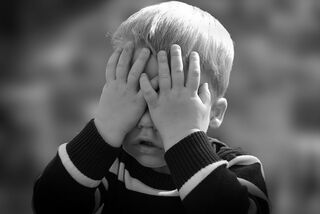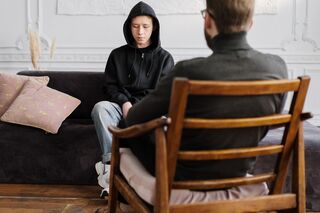Shyness
When Shyness Turns Ugly
Recognizing social anxiety and its sequela.
Posted December 29, 2020
First, if you never learn anything else from this blog, remember this: People who are socially inhibited, shy, or are afraid to socialize, are not “antisocial” as popular culture calls them. Clinically, antisocial is synonymous with sociopathy, or the disregard for, and violation of, the rules of society and rights of others. Antisocial also implies that the person does not want to socialize, when, in fact, many people behaving a-socially desperately want interaction.

The social-inhibition condition
As with any pathology, social angst exists on a continuum. On the “normal” end, for example, are stomach butterflies before a date. Perhaps you're giving a presentation and the “big boss” will be there. Despite blushing and your heart racing, you push through.
On the other end, there's phobic and all-out socially-avoidant behaviors. There is a saying that “nature cocks the hammer and experience pulls the trigger.” Essentially, this means that pathological anxiety is a combination of biological susceptibility to excessive anxiety, coupled with activating experiences shaping how the anxiety manifests.
Social anxiety disorder (SAD) is characterized by a fear of scrutiny. Individuals with SAD desperately want to socialize but fear doing or saying things that will cause embarrassment and shame. It is essentially social performance anxiety and phobic-like in nature. The person realizes their fears are excessive, but can’t shake the “what if?” factor. Teens and adults will steer clear of the anxiety-producing situations, or endure them under great duress, while smaller children may have tantrums to articulate they don't want to be put in the socially-fearful situation.
The three faces of SAD
For many, SAD is generalized to most social situations. For others, it is limited to public speaking. Still others’ experience is limited to paruresis, or fear of urinating if others are around, sometimes called "shy bladder." Anyone who has been oddly unable to relieve themselves in a public restroom with others nearby has experienced this.

While it is not officially considered a subtype of social anxiety, paruresis is not uncommon in people who suffer from SAD, and there are many who experience it as an independent condition. According to the International Paruresis Foundation (2020), 220 million people worldwide report having had the experience. Some are so debilitated by it, they won't go far from home in case of the need to use a public restroom arises.
SAD sequela
Truancy: Since it frequently surfaces in adolescence, it is a topic in many truancy cases I evaluate for Juvenile Court. Attorneys and probation officers often ask if someone can truly have SAD if they are known to have a couple of friends yet avoid school, claiming social angst. The answer is yes. People with SAD often have a few people they socialize with so long as it is more of a 1:1 basis. These are also people that they probably had a relationship with prior to the intensifying social fears.
Considering we’re often most sensitive to scrutiny by our peers, especially as teens, it makes sense that school is a place that would increase distress the most. This does not mean that homeschooling is the answer- that just solidifies the problem by teaching avoidance. Instead, students with SAD must learn to acclimate, via exposure therapy, preferably with a therapist skilled in school-based treatment, and an appropriate Individualized Education Plan. Unfortunately, dropping out is still not unheard of, and the corollary unfruitful adult life ensues.
Substance abuse: SAD is particularly, well, sad, in that onset is usually in the teens, a time when life naturally revolves around socializing. Considering 15 million U.S. citizens suffer from SAD (ADAA, 2020), legions of people have been robbed of the ability to enjoy this time of flourishing, especially with dating. Given that alcohol is “liquid courage” and facilitates socializing, it is not surprising that high rates of alcohol abuse occur (DSM-5; Koyuncu et al., 2019) amongst people with SAD, especially in college.
Depression: It is noted in the DSM-5 that depression amongst SAD sufferers is high, which is easy to understand. Imagine watching your peers doing all the things you wish you could be doing and realizing you’ll never have a time to relive your youth? Remaining paralyzed by the fear of self embarrassment into adulthood, sufferers have often been isolated for years with no semblance of a life.

Not surprisingly, it is difficult for sufferers to seek treatment because talk therapy is a social interaction where you’re expected to talk about yourself, and potentially ripe with scrutiny. According to the ADAA (2020), 1/3 of sufferers take 10 years to seek treatment after onset! Fortunately, it is a very treatable condition with exposure therapy, social skills training, and medications in the Prozac family.
Check it out
The longer symptoms go unchecked, the more chance the youth has of developing debilitating social fears leading to truancy, serious depression, and potentially significant self-medicating that will affect their adult life.
Like most conditions, catching Social Anxiety early is key. Youth therapists should pay attention for rising fears of scrutiny and judgment beyond teen norms, and parents who identify any items here in their child would do well to raise the topic with mental health care providers for further evaluation.
To find a therapist, please visit the Psychology Today Therapy Directory.
References
American Psychiatric Association. (2013). Diagnostic and statistical manual of mental disorders (5th ed.).
Anxiety and Depression Association of America (2020). Understand the facts: Social anxiety disorder. https://adaa.org/understanding-anxiety/social-anxiety-disorder
International Paruresis Foundation. (2020). Making it all make sense. https://paruresis.org/
Koyuncu, A., İnce, E., Ertekin, E., & Tükel, R. (2019). Comorbidity in social anxiety disorder: diagnostic and therapeutic challenges. Drugs in context, 8, 212573. https://doi.org/10.7573/dic.212573




